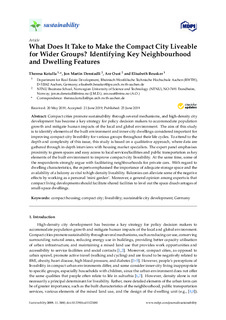| dc.contributor.author | Kotulla, Theresa | |
| dc.contributor.author | Denstadli, Jon Martin | |
| dc.contributor.author | Oust, Are | |
| dc.contributor.author | Beusker, Elisabeth | |
| dc.date.accessioned | 2019-08-28T11:40:54Z | |
| dc.date.available | 2019-08-28T11:40:54Z | |
| dc.date.created | 2019-07-03T11:42:20Z | |
| dc.date.issued | 2019 | |
| dc.identifier.issn | 2071-1050 | |
| dc.identifier.uri | http://hdl.handle.net/11250/2611410 | |
| dc.description.abstract | Compact cities promote sustainability through several mechanisms, and high-density city development has become a key strategy for policy decision makers to accommodate population growth and mitigate human impacts of the local and global environment. The aim of this study is to identify elements of the built environment and inner-city dwellings considered important for improving compact-city liveability for various groups throughout their life cycles. To attend to the depth and complexity of this issue, this study is based on a qualitative approach, where data are gathered through in-depth interviews with housing market specialists. The expert panel emphasises proximity to green spaces and easy access to local services/facilities and public transportation as key elements of the built environment to improve compact-city liveability. At the same time, some of the respondents strongly argue with facilitating neighbourhoods for private cars. With regard to dwelling characteristics, the experts emphasised the importance of adequate storage space and the availability of a balcony as vital to high-density liveability. Balconies can alleviate some of the negative effects by working as a personal ‘mini garden’. Moreover, a general opinion among experts is that compact living developments should facilitate shared facilities to level out the space disadvantages of small-space dwellings. | nb_NO |
| dc.language.iso | eng | nb_NO |
| dc.publisher | MDPI | nb_NO |
| dc.rights | Navngivelse 4.0 Internasjonal | * |
| dc.rights.uri | http://creativecommons.org/licenses/by/4.0/deed.no | * |
| dc.title | What Does It Take to Make the Compact City Liveable for Wider Groups? Identifying Key Neighbourhood and Dwelling Features | nb_NO |
| dc.type | Journal article | nb_NO |
| dc.type | Peer reviewed | nb_NO |
| dc.description.version | publishedVersion | nb_NO |
| dc.source.volume | 11 | nb_NO |
| dc.source.journal | Sustainability | nb_NO |
| dc.source.issue | 12 | nb_NO |
| dc.identifier.doi | 10.3390/su11123480 | |
| dc.identifier.cristin | 1709723 | |
| dc.description.localcode | © 2019 by the authors. Licensee MDPI, Basel, Switzerland. This article is an open access article distributed under the terms and conditions of the Creative Commons Attribution (CC BY) license (http://creativecommons.org/licenses/by/4.0/). | nb_NO |
| cristin.unitcode | 194,60,10,0 | |
| cristin.unitname | NTNU Handelshøyskolen | |
| cristin.ispublished | true | |
| cristin.fulltext | original | |
| cristin.qualitycode | 1 | |

